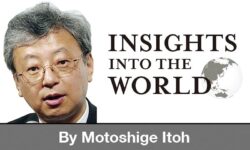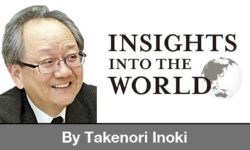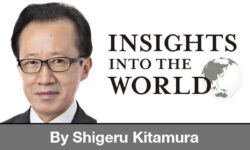17:05 JST, March 22, 2024
The Association of Southeast Asian Nations (ASEAN) is now thriving as the core of world economic growth. Indeed, the regional grouping’s growth rate has surpassed that of China, whose economy has been under pressure to conduct major restructuring. Where does ASEAN’s strength come from?
It groups 10 Southeast Asian countries covering a combined 4.5 million square kilometers, or 3.2% of the world’s land area, and is home to 680 million people, equal to 8.5% of the global population. Its total gross domestic product is on par with that of either Germany or Japan, the world’s third- and fourth-largest economies.
In terms of GDP, Indonesia in particular is likely to outperform Japan in 20 or so years. Many Japanese people may not know that ASEAN includes two countries whose per capita GDP is higher than that of Japan.
In the closing quarter of the 20th century, quite elaborate supply chains were set up in Asia. In those days, Japan played a core role in planning and designing these supply chains, while South Korea, Taiwan, Hong Kong and Singapore were key to implementing the plans. Southeast Asian countries produced intermediate goods, such as components, and China did the final assembly. This division of labor was hailed as a good example of regional cooperation for realizing economic growth.
However, with the start of the 21st century, China began taking advantage of its continent-like sway, given the geographical and demographic size of the country. It established its own supply chains, intensifying trade friction with other countries.
Asia is now seeing more and more supply chains. These need to be reorganized and strengthened to create a West Pacific supply chain that links South Korea, Japan, Taiwan, ASEAN, Australia and New Zealand.
As part of those efforts, Japan should open up the planning and design process it has so far monopolized, while assuming an important role in providing funds and safeguarding free trade.
The “de-risking” that the United States is directing toward China is also affecting the whole Asian region, including Japan. That policy is, of course, having negative impacts, but it has also had some positive side effects.
For example, Vietnam is now ranked remarkably high on the list of countries exporting smartphones to the United States.
The main reason for this is that production sites were relocated from China to Vietnam not only by South Korean companies but also by Chinese-U.S. joint ventures. They wanted to avoid “Made in China” or “Shipped from Hong Kong” labels, as the United States has increasingly been curbing imports of electronics from China.
It is ironic that Vietnam, the ASEAN member that is toughest on China, is getting windfall gains thanks to such a situation.
A global growth promoter
Now let’s turn to the ASEAN economy. Where is it headed?
ASEAN has borne the brunt of increased borrowing costs and reduced funding volume since monetary tightening by the U.S. Federal Reserve led to higher interest rates. Nevertheless, most analysts expect ASEAN to retain for some time its status as a global leader in economic growth.
Currently, the grouping’s reliance on trade with non-ASEAN advanced economies and China is extremely high — accounting for about 80% of ASEAN’s exports and imports. As a result, the proportion of trade within the regional grouping is low. Considering the likelihood that ASEAN’s middle class will soon increase to about 200 million, a big challenge for the grouping will be to boost intraregional trade, such as by creating brand strength.
With the world’s population expected to rise from about 8 billion to nearly 10 billion by 2050, food security will inevitably become an even more important issue. In this respect, ASEAN will be in a good position thanks to a very high food self-sufficiency ratio.
ASEAN also has a geographical advantage — it is located between China and India, the two important pillars for the world economy going forward. China and India are unlikely to completely reconcile due to historical factors. ASEAN, for its part, could establish collaborative relationships with both of them while skillfully maintaining a balance.
ASEAN’s diversity also lends it strength on a variety of issues.
The political systems of its member countries range from absolute or constitutional monarchy to autocratic democracy, mass democracy and socialism. ASEAN has significantly transformed itself since it was originally founded to prevent the spread of communism in the region.
As for religion, ASEAN is a place of coexistence for Buddhists, Christians, and strict and more tolerant Muslims.
Gender equality in the region is much further along than in Japan and South Korea, though this may be limited to parts of the wealthy class.
I once took part in an ASEAN Plus Three meeting that was attended by finance ministry and central bank officials from the ASEAN member countries as well as Japan, China and South Korea. There were 26 participants: 13 men and 13 women. The four attendees from Japan and South Korea were all male, whereas two ASEAN member countries were represented only by women. In many parts of ASEAN, women are active in a variety of fields.
Japanese people naturally tend to think of themselves as Asians. But, when seen from China and other countries on the Asian continent, Japan is a small island nation floating in a sea to the northeast — just the fringe of Asia.
Japan began industrializing in the 19th century by following Western Europe’s industrial revolution via the United States. In other words, Japan paved a path to growth as “a Far Western nation.” It did not achieve its success as a Far Eastern nation collaborating with countries on the Asian continent.
A sense of security
During World War II, Japan carved out an unfortunate history with Asian countries. Even if Japanese people forget what happened, people in these countries will not. In fact, there are countries that even now celebrate each anniversary of victory over Japan.
To overcome such ill will, Japan’s then Prime Minister Takeo Fukuda delivered a speech in Manila in 1977, outlining three principles known as the Fukuda Doctrine for Japan’s diplomacy in Southeast Asia.
Fukuda promised that Japan “rejects the role of a military power”; would, as “a true friend” of the countries of Southeast Asia, consolidate bilateral ties based on a “heart-to-heart understanding” with them; and would, as “an equal partner” of ASEAN, “contribute to the building of peace and prosperity throughout Southeast Asia.”
Unlike China, a country that is constantly at odds with neighboring countries, these three principles create a sense of security. Acting on the basis of these principles, Japan has helped ASEAN reduce excessive economic imbalances, improve intraregional connection and promote balanced development.
Japan has, for example, helped build an east-west road on the Indochina Peninsula running from Vietnam to Myanmar — a project that was meant to rival a Chinese-led project to build a north-south road on the peninsula. The road has been highly effective in allowing countries along the economic corridor to work together instead of focusing on their differences.
ASEAN is expected to try to keep its relationships with Japan, the United States, Australia, China and India on an equal footing to ensure its security and keep its economic zone intact.
At the same time, the regional grouping is moving to take further advantage of the strengths of each of these non-ASEAN partners. In a sense, this is a natural and correct stance for ASEAN.

Hiroshi Watanabe
Watanabe is president of the Tokyo-based Institute for International Monetary Affairs. Previously, he served as vice finance minister for international affairs, and governor and chief executive officer of the Japan Bank for International Cooperation.
The original article in Japanese appeared in the March 17 issue of The Yomiuri Shimbun.
"Editorial & Columns" POPULAR ARTICLE
-

Violations of Subcontract Law: Major Automakers Must Eliminate Old Practices
-

Local Governments’ Tax Revenues: Devise Ways to Correct Imbalances in Tax Sources
-

5 Japanese Business Dinner Mistakes to Avoid — and What They Taught Me About Business in Japan
-

Heavy Rains in Asia: Support for Victims, Flood-Control Measures Urgently Needed
-

Rice Coupons: A Misguided Approach to Countering Rising Prices
JN ACCESS RANKING
-

Keidanren Chairman Yoshinobu Tsutsui Visits Kashiwazaki-Kariwa Nuclear Power Plant; Inspects New Emergency Safety System
-

Imports of Rare Earths from China Facing Delays, May Be Caused by Deterioration of Japan-China Relations
-

University of Tokyo Professor Discusses Japanese Economic Security in Interview Ahead of Forum
-

Tokyo Economic Security Forum to Hold Inaugural Meeting Amid Tense Global Environment
-

Japan Pulls out of Vietnam Nuclear Project, Complicating Hanoi’s Power Plans
























